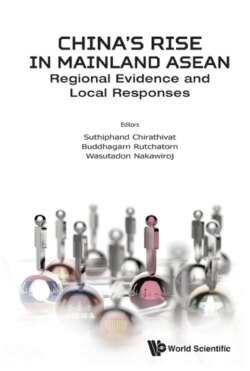Читать книгу China's Rise in Mainland ASEAN - Группа авторов - Страница 14
На сайте Литреса книга снята с продажи.
1.2.4.Connectivity in Focus
ОглавлениеThe last section illustrates a few important aspects of connectivity dynamics, from the past up to the present, which will help better understand the future outlook of connectivity between China and mainland ASEAN. Precisely, Stan BH Tan-Tangbau, in his chapter, “Experiencing the Dian-Việt Railway Corridor as Panoramization: A View from the Past,” explains how as inhabitants of transborder China–Mainland Southeast Asia enter the third decade of the 21st century, it would not be controversial to say “we” since Southeast Asians feel the pervasiveness of “China”. There is no escaping China, especially with the heightened connectivity through the BRI. This is just the beginning, as the chapters of this volume remind us: “China is now and will continue to be a part of our everyday life”. Heightening of connectivity in the transborder space between China and Mainland Southeast Asia is not a new phenomenon; it has happened before. In the case of Vietnam, realization of the transborder railway corridor between Hai Phong and Kunming at the start of the 20th century provided us with a historical context to consider local dynamics at play in specific nodes of interaction. This chapter, thus, applies Schivelbusch Wolfgang’s concept of “panoramization” to show how meta-categories of China and Vietnam (French Indochina) then translate into a “panorama that could be experienced” through travel in the process of developing the Dian-Viet railway corridor. The author suggests two things that could be picked up from the optic of panoramization. First, these meta-categories are but among multiple components that complete the panoramic experience at every node of connectivity. Second, as much as the Dian-Viet Railway was driven by French colonial ambitions to penetrate China, the corridor was no simple unidirectional conduit transporting French imperialism inland. A critical revisit of the historical geography of the Dian-Viet Railway corridor, the chapter suggests, could unveil local dynamics that might occur in transborder reconfigurations beneath China’s rising influence in mainland Southeast Asia.
Nisachol Thaithong and Nisarat Thaithong’s chapter, “Thailand–Laos–Vietnam and Southern China: Land Logistic and Transportation,” was based on a survey in Southern China, Vietnam, Laos, and Thailand. Since the last sub-prime crisis of 2008, China and the mainland ASEAN countries’ strengthening of connectivity through land route infrastructure has been necessary for promoting regional competitiveness and mutual trust for both sides. Viewed from different cross- and sub-regional initiatives like the BRI, the upgraded version of the ASEAN–China FTA, the China–Indochina Economic Corridor, the Lancang–Mekong Cooperation (LMC) mechanism, and the “Chongqing–Guangxi–Singapore” International Intermodal Transport route, this chapter aims to discuss the necessity and urgency of building and optimizing international land logistics corridors among China, Laos, Thailand, and Vietnam. First, analyses of the present cross-border transportation network among these four countries are shown, with main highway facilities, port customs clearance, future upgrading plans, and financial resources. Then, mixed and comparative study approaches have been applied with the calculation of demand for international land logistic trade among these countries, which also includes the logistic trade of subsidiary agricultural products and industrial products. Finally, the chapter puts forward a few suggestions on how to promote transportation efficiency and enable trade facilitation of international land logistics among these four countries. In this a way, this chapter also aims to make contributions to the building up of the “Golden Logistics Route” between Thailand, Laos, Vietnam, and Guangxi province — the gate to the Southeastern region of China — and fully exploit complementarities among these economies and their sub-regions.
The last chapter of this volume by Wasutadon Nakawiroj, Pak Veerastien, and Buddhagarn Rutchatorn “The E-commerce Landscape in ASEAN and China: A Virtual Bridge between the World’s Largest Market and ASEAN’s Emerging Markets,” describes the spirit of ongoing trends and the situation of e-commerce markets of ASEAN countries in mainland China, given the rising prominence of the e-commerce sector in both regions. The authors’ work examines the movements of notable players ranging from global and regional powerhouse platforms to the small C2C interactions within ASEAN and China. The general properties and trends of e-commerce in both regions are addressed so as to provide useful information on the matter, followed by an examination of important issues that are the determining factors of success and failure in the e-commerce sector.
The chapter began with illustrations of the current situation of e-commerce and the present outlook of the ASEAN market, and then proceeds specifically to address the Thai and Chinese markets as a case study. The dominance of regional power players, like Lazada, and the regional-global market leader, the Alibaba Group, and their strategic links are analyzed, as these seem to define an important chain of events in the changing landscape of regional e-commerce. Subsequently, the chapter provides policy implications in terms of e-commerce itself, start-up ecosystems, and the ensuing policy consideration for addressing the ongoing and future situations in ASEAN and Asian e-commerce markets. With the ongoing momentum of intra-regional and extra-regional e-commerce waves, the public sector will need to facilitate growth of technology entrepreneurs, start-ups and platform providers, and, above all, human talents, while the private players should adopt and utilize technological capabilities and seek out strategic assets, which are skilled technical talents, innovation, and well-established networks of consumers.
